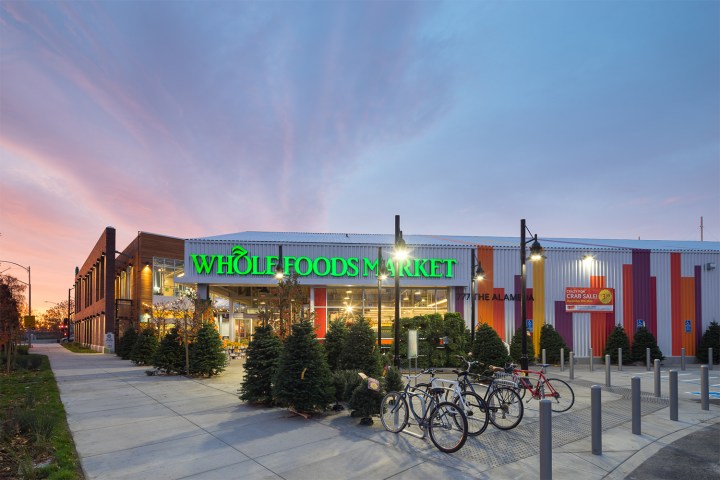When Amazon brought its Go store to New York City earlier this year, it had something the others didn’t: cashiers. The city was in the midst of an outcry against other cashless businesses, so Amazon agreed to let customers pay with dollars and cents. Now the company wants to expand the cashierless technology. It plans on putting it in full-size supermarkets and licensing it to other retailers, according to Bloomberg News.
The Amazon Go stores were originally meant to be totally cashierless. Customers scan an app to enter, pick up their items around the shop — continually tracked by cameras that see everything you put in your tote bag — and then walk out (unless you’re picking up a bottle of wine or a six-pack of beer, in which case an employee still checks your ID). The receipt shows up on the app, and your credit card is charged accordingly. Critics said the stores discriminated against the unbanked, and other people who don’t have credit cards. Proponents say it cuts down on theft and is more efficient.

About 25 percent of U.S. households are unbanked or underbanked, according to a 2017 FDIC survey. In October, Philadelphia’s ban on cashless stores went into effect. Salad chain Sweetgreen is one operation that had to start accepting cash. Massachusetts hasn’t allowed cashless stores since 1978, and New Jersey passed a similar ban earlier this year. New York City, San Francisco, and Chicago have all considered similar actions.
“We never said you have to give cash to a human being,” William Greenlee, the Philadelphia councilman who proposed the city’s cashless ban, told Digital Trends. He points out that lots of businesses, like his pharmacy, use machines that accept either cash or credit cards. “We were thinking about the convenience of the customer, because there are certain people that just don’t have a credit card,” he said. “Either they didn’t choose to or, in a lot of cases, they can’t. They’re unbanked.”
Because of the cashierless stores, Amazon was accused of “elitism” and was criticized for not accepting SNAP benefits. With Amazon Go, customers originally not only had to have a credit card but an Amazon account and smartphone with the app. The gates that let customers in and out open when they scan a QR code on the device. In the New York store, it’s possible to get an employee to let you in, and then someone will use a handheld scanner to tally your purchases. Editor of SupermarketGuru Phil Lempert agrees checkouts are too slow and more investment is needed in making it more seamless. He’s skeptical, though, that many older customers will feel comfortable with this kind of experience. “When you get into the mass market, it’s scary to a lot of consumers,” he said, “especially Boomers and older, which still represent a lot of the population.”

Amazon also owns Whole Foods and is planning on opening a lower-priced grocery store with more mainstream items. The Los Angeles store won’t be cashierless, but that doesn’t mean it won’t provide insight into customers and shopping habits. “When Amazon bought Whole Foods, it was a wake up call to the entire industry,” Lempert said. “The industry started putting more money in data collection, more money in technology.”
The current Amazon Go stores are more like convenience stores, heavy on prepackaged food and light on options. They do sell some fruits and vegetables, but it’s not clear how full-sized stores will handle a larger selection of items, upwards of 40,000, including those that need to be weighed. One company, Caper, is working on smart shopping carts that lets shoppers scan items and have sensors to track weight. Lemper said smart cart technology has been around for decades and is expensive to repair. It makes more sense, he thinks, to give people the option to use their own smartphones to check out — if they want to. “I think 20 years from now it’ll be pervasive,” said Lempert.
Amazon Go stores don’t have carts at all. Their compact size — between around 1,500 and 3,000 square feet — would make pushing carts cumbersome. On the flip side, larger grocery stores, like the 10,400-square-foot one Amazon is testing in Seattle, require a lot more cameras than the average Go store. The company is working on getting the cost of the equipment down, Bloomberg reports. Amazon did not respond to a request for comment.
Amazon isn’t alone in trying to get more customers to go cashless. Zippin, Trigo Vision, and similar companies are working on cashierless technology. But if cities and states keep pushing back with laws requiring stores to take cash, customers will still have the option of paying their preferred way.


